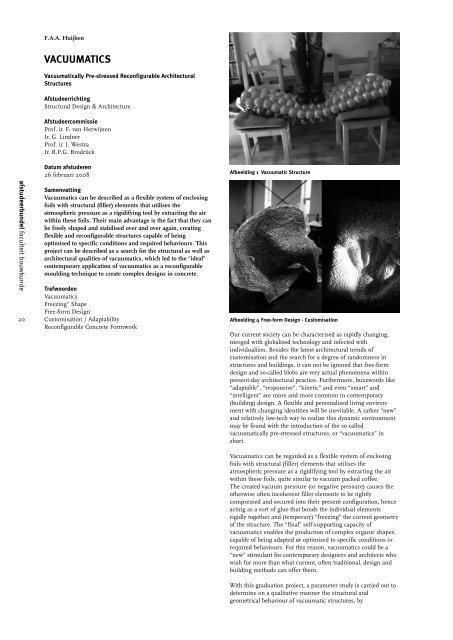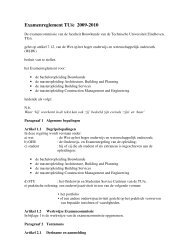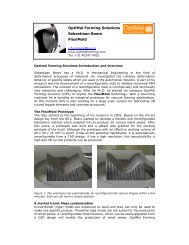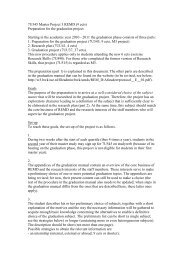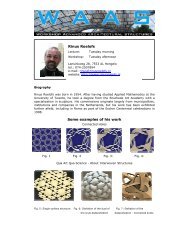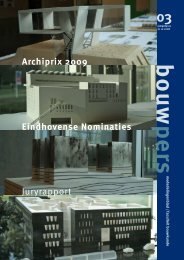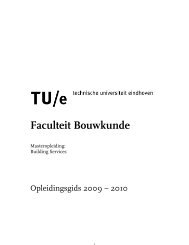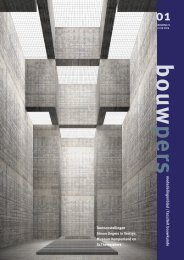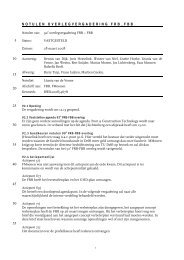afst.bundel 8 MEI 07 - Technische Universiteit Eindhoven
afst.bundel 8 MEI 07 - Technische Universiteit Eindhoven
afst.bundel 8 MEI 07 - Technische Universiteit Eindhoven
You also want an ePaper? Increase the reach of your titles
YUMPU automatically turns print PDFs into web optimized ePapers that Google loves.
F.A.A. Huijben<br />
VACUUMATICS<br />
Vacuumatically Pre-stressed Reconfigurable Architectural<br />
Structures<br />
Afstudeerrichting<br />
Structural Design & Architecture<br />
Afstudeercommissie<br />
Prof. ir. F. van Herwijnen<br />
Ir. G. Lindner<br />
Prof. ir. J. Westra<br />
Ir. R.P.G. Brodrück<br />
Datum <strong>afst</strong>uderen<br />
26 februari 2008<br />
Afbeelding 1 Vacuumatic Structure<br />
<strong>afst</strong>udeer<strong>bundel</strong> faculteit bouwkunde<br />
20<br />
Samenvatting<br />
Vacuumatics can be described as a flexible system of enclosing<br />
foils with structural (filler) elements that utilises the<br />
atmospheric pressure as a rigidifying tool by extracting the air<br />
within these foils. Their main advantage is the fact that they can<br />
be freely shaped and stabilised over and over again, creating<br />
flexible and reconfigurable structures capable of being<br />
optimised to specific conditions and required behaviours. This<br />
project can be described as a search for the structural as well as<br />
architectural qualities of vacuumatics, which led to the “ideal”<br />
contemporary application of vacuumatics as a reconfigurable<br />
moulding technique to create complex designs in concrete.<br />
Trefwoorden<br />
Vacuumatics<br />
Freezing” Shape<br />
Free-form Design<br />
Customisation / Adaptability<br />
Reconfigurable Concrete Formwork<br />
Afbeelding 4 Free-form Design - Customisation<br />
Our current society can be characterised as rapidly changing,<br />
merged with globalised technology and infected with<br />
individualism. Besides the latest architectural trends of<br />
customisation and the search for a degree of randomness in<br />
structures and buildings, it can not be ignored that free-form<br />
design and so-called blobs are very actual phenomena within<br />
present-day architectural practice. Furthermore, buzzwords like<br />
“adaptable”, “responsive”, “kinetic” and even “smart” and<br />
“intelligent” are more and more common in contemporary<br />
(building) design. A flexible and personalised living environment<br />
with changing identities will be inevitable. A rather “new”<br />
and relatively low-tech way to realize this dynamic environment<br />
may be found with the introduction of the so called<br />
vacuumatically pre-stressed structures, or “vacuumatics” in<br />
short.<br />
Vacuumatics can be regarded as a flexible system of enclosing<br />
foils with structural (filler) elements that utilises the<br />
atmospheric pressure as a rigidifying tool by extracting the air<br />
within these foils, quite similar to vacuum packed coffee.<br />
The created vacuum pressure (or negative pressure) causes the<br />
otherwise often incoherent filler elements to be tightly<br />
compressed and secured into their present configuration, hence<br />
acting as a sort of glue that bonds the individual elements<br />
rigidly together and (temporary) “freezing” the current geometry<br />
of the structure. The “final” self-supporting capacity of<br />
vacuumatics enables the production of complex organic shapes,<br />
capable of being adapted or optimised to specific conditions or<br />
required behaviours. For this reason, vacuumatics could be a<br />
“new” stimulant for contemporary designers and architects who<br />
wish for more than what current, often traditional, design and<br />
building methods can offer them.<br />
With this graduation project, a parameter study is carried out to<br />
determine on a qualitative manner the structural and<br />
geometrical behaviour of vacuumatic structures, by


